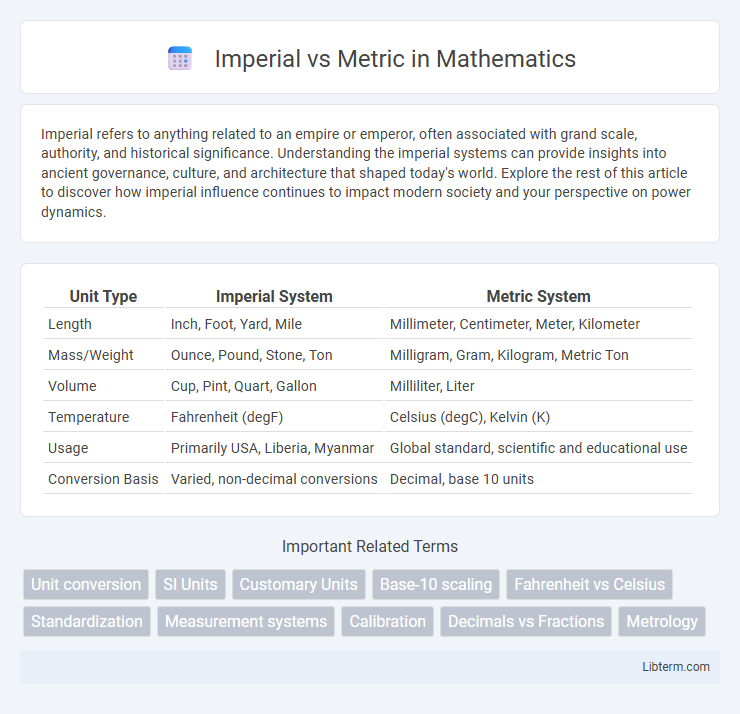Imperial refers to anything related to an empire or emperor, often associated with grand scale, authority, and historical significance. Understanding the imperial systems can provide insights into ancient governance, culture, and architecture that shaped today's world. Explore the rest of this article to discover how imperial influence continues to impact modern society and your perspective on power dynamics.
Table of Comparison
| Unit Type | Imperial System | Metric System |
|---|---|---|
| Length | Inch, Foot, Yard, Mile | Millimeter, Centimeter, Meter, Kilometer |
| Mass/Weight | Ounce, Pound, Stone, Ton | Milligram, Gram, Kilogram, Metric Ton |
| Volume | Cup, Pint, Quart, Gallon | Milliliter, Liter |
| Temperature | Fahrenheit (degF) | Celsius (degC), Kelvin (K) |
| Usage | Primarily USA, Liberia, Myanmar | Global standard, scientific and educational use |
| Conversion Basis | Varied, non-decimal conversions | Decimal, base 10 units |
Introduction to Measurement Systems
Imperial and metric are two primary measurement systems used worldwide, with the metric system based on powers of ten, facilitating easier calculation and conversion. The imperial system, still prevalent in the United States and a few other countries, uses units like inches, feet, and pounds, rooted in historical standards. Understanding these systems is crucial for scientific accuracy, international trade, and everyday measurements.
Historical Origins of Imperial and Metric
The Imperial system originated in the British Empire during the early 19th century, formalized by the Weights and Measures Act of 1824 to standardize diverse regional units for trade and governance. The Metric system was developed in late 18th-century France, inspired by the Enlightenment's emphasis on rationality and uniformity, with the meter introduced as a universal unit based on the Earth's meridian. These historical origins reflect differing approaches: the Imperial system rooted in tradition and colonial administration, while the Metric system prioritized scientific standardization and international applicability.
Key Differences Between Imperial and Metric
The Imperial system uses units such as inches, feet, pounds, and gallons, while the Metric system relies on meters, kilograms, and liters, based on powers of ten for easier calculation. Measurement conversion within the Metric system is more straightforward due to its decimal structure, contrasting with the Imperial system's varied conversion factors. The Metric system is globally recognized and adopted for scientific and international use, while the Imperial system remains primarily in use in the United States and a few other countries.
Units of Length: Inches vs. Centimeters
Inches, a fundamental unit in the Imperial system, measure length with 1 inch equaling 2.54 centimeters in the Metric system, which uses centimeters as a base unit for smaller lengths. The Metric system's centimeters provide a decimal-based measurement preferred for scientific precision and international standardization. Inch measurements remain prevalent in the United States and the United Kingdom for everyday applications, while centimeters dominate most global contexts due to ease of conversion and universal adoption.
Weight and Mass: Pounds vs. Kilograms
Pounds measure weight based on the Imperial system, commonly used in the United States, while kilograms represent mass in the Metric system, widely adopted globally. One pound equals approximately 0.4536 kilograms, making the kilogram a larger unit for quantifying mass. Understanding the distinction between weight (force due to gravity) measured in pounds and mass measured in kilograms is essential for accurate scientific and practical applications.
Volume Measurements: Gallons vs. Liters
The imperial gallon, used primarily in the United Kingdom, equals approximately 4.546 liters, while the US gallon, common in the United States, measures about 3.785 liters, creating significant differences in volume measurements. Liters, the standard unit of volume in the metric system, provide a consistent and universally accepted measurement across most countries worldwide. Understanding these variations is crucial for accurate conversions in international trade, cooking, and scientific applications.
Global Adoption and Regional Preferences
The metric system dominates global measurement standards, with over 95% of countries adopting it for scientific, industrial, and everyday use due to its decimal-based simplicity and universal consistency. The imperial system remains primarily in use within the United States, Liberia, and Myanmar, reflecting historical influences and regional preferences in trade, construction, and daily measurements. International organizations and scientific communities advocate metric units to facilitate cross-border collaboration and data comparison, reinforcing its status as the global standard despite localized retention of imperial units.
Conversion Challenges and Practical Impacts
Converting between Imperial and Metric systems involves complex challenges due to differing base units, such as inches versus centimeters and pounds versus kilograms, leading to frequent calculation errors and measurement inconsistencies. These difficulties impact industries like construction, engineering, and manufacturing, where precise conversions are critical to ensuring safety and product compatibility. The practical impacts include increased costs, project delays, and communication barriers, highlighting the need for standardized measurement practices in global operations.
Scientific Use and Standardization
Scientific use prioritizes the metric system due to its standardized base-10 structure, enabling precise measurements and easy unit conversions essential for research and data analysis. The metric system's global standardization by the International System of Units (SI) facilitates consistent communication and collaboration across scientific disciplines and countries. In contrast, the imperial system lacks uniformity and is rarely used in scientific contexts, limiting its applicability for standardized data exchange and international research.
The Future of Measurement Systems
The future of measurement systems is increasingly leaning toward the metric system due to its universal standardization and ease of use in scientific, medical, and international trade contexts. Technological advancements and global communication demand consistent measurement units, prompting many countries to adopt or transition fully to metric standards. Innovations in digital measurement tools and data interoperability further accelerate the shift away from the imperial system to a harmonized metric framework.
Imperial Infographic

 libterm.com
libterm.com